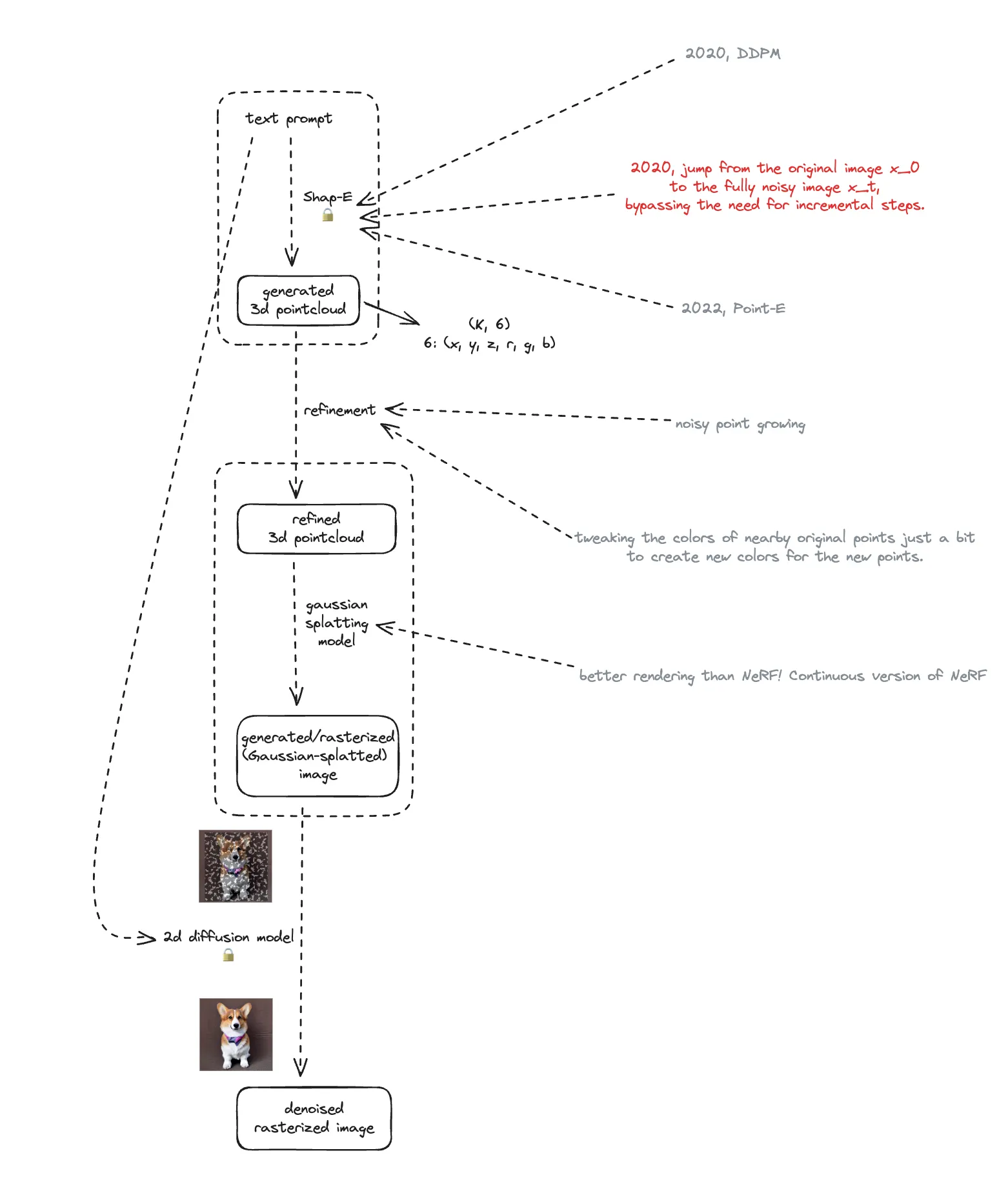Shap-E 라는 2D to 3D Model 을 이용해서 3D pointcloud 를 만든다. 3D pointcloud 에 약간의 후처리 과정을 거친 다음, gaussian splatting 모델의 초기화값으로 사용한다. GaussianDreamer 의 최종 목표는 gaussian splatting 모델을 학습해 Implicit representation 을 생성하는 것이다.
Gaussian Splatting 은 NeRF 의 연속판이라고 추상적으로 이해할 수 있다. NeRF는 ray 기반의 렌더링 결과물을 GT Image 와 비교해 최적화하는 모델이다. Gaussian Splatting은 점 대신 가우시안을 사용한다. 구체적인 렌더링 방법은 조금 다르지만, 렌더링 결과물 이미지와 GT Image 를 비교해 최적화한다.
NeRF 와 마찬가지로, Gaussian Splatting 모델을 학습하기 위해서도 GT Image 가 필요한데 생성된 3D pointcloud 로부터 렌더링하는 것이기 때문에 당연히 GT Image 를 확보할수가 없다. 이 문제를 해결하기 위해 2D 디퓨전모델을 사용한다.
Gaussian Dreamer 에서 디퓨전 모델은 래스터화된 2D 이미지의 노이즈를 제거해서 3D 표현을 최적화하기 위한 도구로 여겨진다. 이때 사용될 수 있는 손실이 SDS 손실과 SJC 손실이다. SDS 손실과 SJC 손실을 제안한 논문에서는 3D 표현 모델로 NeRF를 사용했다. Gaussian Dreamer 에서는 NeRF 대신 Gaussian Splatting 을 사용하여 속도와 성능을 높였다.
parse me : 언젠가 이 글에 쓰이면 좋을 것 같은 재료을 보관해 두는 영역입니다.
1.
Dreambooth 는 UNet 전체를 fine-tuning 해서 비효율적임. Parameter efficient fine-tuning (PEFT) & LoRA
2.
To enrich details and improve the quality of the 3D asset, we optimize the 3D Gaussians θb with a 2D diffusion model after initializing them with 3D diffusion model priors. We employ the SDS (Score Distillation Sampling) loss to optimize the 3D Gaussians. First, we use the method of 3D Gaussian Splatting [24] to obtain the rendered image x = g(θi). Here, g represents the splatting rendering method as in Eq. 3. Then, we use Eq. 1 to calculate the gradients for updating the Gaussian parameters θi with the 2D diffusion model . After a short optimization period using the 2D diffusion model , the final generated 3D instance θf achieves high quality and fidelity on top of the 3D consistency provided by the 3D diffusion model .
•
해당 논문 5페이지
3.
카메라 렌더링 결과물을 UNet 에 넣을 때..
•
카메라 position query → gaussian splatting model → output rasterized image → UNet
◦
카메라는 어떻게 세팅하는지?
◦
카메라 세팅 정보를 텍스트와 함께 UNet 에 어떻게 넣는지?
•
UNet 을 몇 번 돌리는지. T 번을 다 돌리는지?
◦
깨끗한 이미지가 나와도 T 번을 다 돌리는지?
from : 과거의 어떤 원자적 생각이 이 생각을 만들었는지 연결하고 설명합니다.
1.
None
•
연결한 이유
supplementary : 어떤 새로운 생각이 이 문서에 작성된 생각을 뒷받침하는지 연결합니다.
2.
opposite : 어떤 새로운 생각이 이 문서에 작성된 생각과 대조되는지 연결합니다.
1.
None
to : 이 문서에 작성된 생각이 어떤 생각으로 발전되거나 이어지는지를 작성하는 영역입니다.
1.
None
ref : 생각에 참고한 자료입니다.
1.
what we need to optimize are 1) the position (p), 2) transparency (alpha), 3) the covariance matrix (sigma), and 4) the color information represented by SH coefficients. … With these straightforward equations and adjustments to coefficients, you can represent various colors, as shown below. The point is that you can represent a 2D image using equations rather than storing actual RGB values. … SH is essentially an attempt to apply this methodology to 3D.
